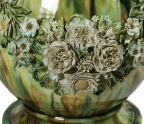The Art of Threatened Species

Floral motifs and plant designs have adorned the ceramic surface for millennia, providing an endless source of shapes and patterns, unthreatening and calming; connecting us to the lifeforce of a tamed nature. The earliest motifs were likely scratched into soft clay and developed throughout culture and time in endless styles, using various techniques. The depiction of whole plants with botanical accuracy emerged from the Chelsea factory in London around 1755, inspired by scientific developments in botanical illustration alongside technological advances in English porcelain and china painting.1 The famous 2000-piece Flora Danica made by the Royal Copenhagen factory is an example of this approach, painted from the botanical work Flora of the Kingdom of Denmark.
Like those before me, I too am attracted to plants as the subject matter of my ceramic practice. Aware of my surroundings, I depict the local flora near Canberra where I live and work – as well as further afield throughout Australia. My approach comes from a scientific perspective, which reflects my background and interests. This means I am inclined to make botanically accurate life-size representations of whole plants, not just the flowers, and
You’re reading a preview, subscribe to read more.
Start your free 30 days





